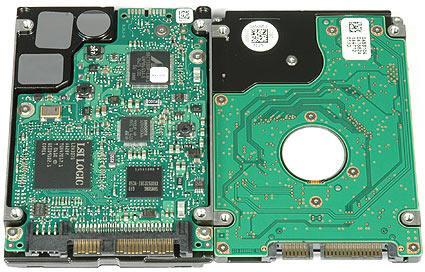AMCC, Areca & LSI Serial RAID Controllers
SAS And SATA Under One Umbrella
SAS (left) vs. SATA: The SAS connector is continuous and does not have a gap between the data pins (left) and the power connector.
When IDE (Integrated Drive Electronics) and SCSI storage interfaces (Small Computer System Interface) were widely in use, IDE was considered cheap and slow, while SCSI was expensive and blazing fast. The first was used for end-user and business PCs, while SCSI was the storage standard for servers and workstations, but also for peripherals such as high-end scanners. Consumer motherboards offered an IDE controller based on an ATA standard with two separate controller channels that supported two devices.
ATA standards ranged from ATA-1 at 8.3 MB/s in 1989 up to 133 MB/s for UltraATA/133 with ATA-7 (2005). The early ATA standards suffered from compatibility issues, as two drives would not always work reliably together on an ATA channel when configured as master/slave. SCSI, on the other hand, has been more reliable, yet more complex to configure. SCSI requires termination to eliminate signal reflection on the bus, and the user is required to assign a SCSI ID to each device. An automatic configuration mechanism called SCAM (SCSI Configured Automatically) was often available, but it never became successful. In the end, everyone with a small budget went for IDE/ATA drives, while corporate users had to go for SCSI due to reliability and performance.
Things started to change with the advent of Serial ATA, because it solved all issues of parallel ATA without becoming more expensive by offering a serial point-to-point interconnect for each drive. This allows for simpler cabling (seven conductors instead of a 40-wire ribbon cable) and makes the maximum bandwidth of 150 or 300 MB/s available to each drive. Some professional features, such as command queuing, were implemented with the first updates to the Serial ATA standard. Also, there is no configuration involved for SATA.
SAS, which is the abbreviation for Serial Attached SCSI, is a serialized version of the parallel SCSI bus. Both SATA and SAS are based on an 8-bit/10-bit encoding (10 bits transferred for 8 bits of data). The clock speed of 3, 6 and 12 GHz translates into 2.4, 4.8 and 9.6 Gb/s, resulting in 300, 600 and 1200 MB/s gross bandwidth for the interface (600 and 1200 MB/s will be available in the future). SAS supports so-called expanders, which can be compared to network switches, and SAS drives come with dual data ports; they can be used for redundancy or performance applications.
The really nice part about SAS is that is it does not only run its own SSP (the SAS SCSI Protocol), but it includes STP (the SATA Tunneling Protocol). The latter allows all SAS controllers to run Serial ATA hard drives. By using professional controllers such as the devices in this roundup, it is possible to create either high-capacity SATA RAID arrays using hard drives at up to 1 TB, or high-performance SAS arrays with 15,000 RPM server drives. You could even create both types as long as your controller offers sufficient SAS ports.
Get Tom's Hardware's best news and in-depth reviews, straight to your inbox.
Current page: SAS And SATA Under One Umbrella
Prev Page SAS And SATA RAID, Powered By Unified Serial Controllers Next Page How RAID Controllers Evolved
Patrick Schmid was the editor-in-chief for Tom's Hardware from 2005 to 2006. He wrote numerous articles on a wide range of hardware topics, including storage, CPUs, and system builds.


